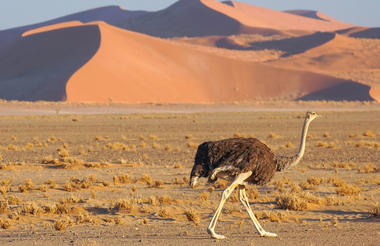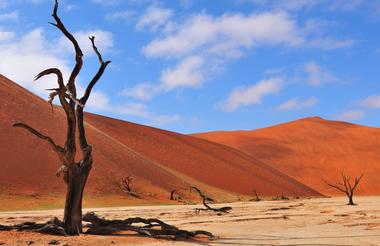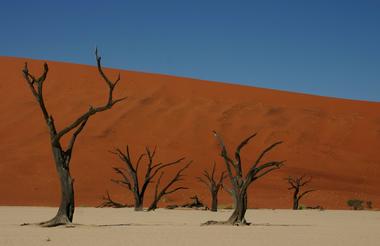There's the option for a leisurely start as you'll leave Swakopmund at 11:30 am. There are many opportunities to keep busy during the morning. Our guide will discuss all the options with you and will be able to facilitate any bookings that you would like to make.
Departing at 11:30 am after being picked up from the airport or your accommodation, you'll head east into the desert. You'll first cross the Namib gravel plains and have two mountain passes to traverse this afternoon. You'll emerge from the mountains onto a flat road and almost immediately cross the Tropic of Capricorn at 23.5 degrees. Your destination for today is Desert Camp, located very close to the national park entrance at Sesriem. You'll aim to arrive in the late afternoon. There will be time for a short walk to see the sun dip below the impressive Naukluft Mountains.
NOTE: No single supplement will be charged if you are willing to share a room with another single traveller of the same sex.
Driving time: ~4 1/2 hours.



Sunrise in the dunes is the name of the game this morning and that means a pre-dawn start and a very early breakfast. The best time to photograph the dunes is around sunrise and sunset. This is when you can see towering sand dunes illuminated a glowing orange, apricot red on one side and swathed in shadow on the other. The depth of field is amazing at this time of day. From Sesriem we cover the 60 km into the dunes quickly and arrive at the 2x4 car park where all 2 wheel drive vehicles have to stop. From here we enter the ancient Tsauchab River-bed for the last 5km leg to Sossusvlei itself. The Tsauchab River is ephemeral, it only flows seasonally, when there is enough rain, and for the most part the riverbed is dry. Eons ago, during these rare floods the Tsauchab sometimes received enough water to flow all the way to the Atlantic Ocean. However, as the millennia passed and the dune fields began to form, (around five million years ago), wind -blown sand invaded the riverbeds. The rivers became more and more constricted by sand until eventually the occasional floods could not break through the sand barriers that had been erected by the wind. The valley we drove along this morning to get here is kept free of sand by the Tsauchab but Sossusvlei is now permanently waters end. Sossusvlei does still sometimes flood, (perhaps once in a decade). After good rains in the Naukluft Mountains where the river rises Sossusvlei can become inundated, and the lake that this creates can last for many months, but no longer can the river find its original path to the Atlantic. There is a 4x4 shuttle service that will transport us through the sandy terrain of the river-bed. We will visit Dead Vlei, an ancient pan completely surrounded by dunes, that is strikingly populated with dead, skeletal camelthorn trees. These trees have been a feature on this landscape for over 1000 years. Sossusvlei is almost surrounded by dunes, just one narrow path kept open by the Tsauchab River. We have time to explore the area on foot and to climb one of the highest dunes in the world, some towering 300 m above us, the views are breathtaking and justly famous. We drive back the way we came, (there is only one road), stopping at the iconic Dune 45, (so named as it is 45 km from Sesriem. There is time to climb Dune 45 if you still have energy, or perhaps just a sit in the shade at the base of the dune will suffice. Driving back to Sesriem we take a short excursion to see the Sesriem Canyon. Only four km from Sesriem, this canyon has been carved out of the landscape by the Tsauchab River. Around two million years ago there was an ice age in Europe. This caused glaciers to form and resulted in a worldwide drop in sea level. The knock on effect of this at Sesriem Canyon was that it increased the length and waterflow of the Tsauchab River. This greater force of water allowed the Tsauchab to begin cutting through the terrain resulting in the canyon we can see today. We can easily walk into the riverbed, it is usually much cooler in the canyon and we can follow the river for some way along its journey to Sossusvlei. We head back to Desert Camp in the late afternoon.


Our last day today but excitement is still on the menu. We head back to Solitaire and join open vehicle to visit one of their local conservation projects, in this case cheetah. Solitaire is home to a number of cheetah that, for different reasons, are unable to be released back into the wild, for different reasons. This excursion allows us the chance to learn all about the cheetah, the work done by local conservation projects, and also get some incredible photos of the world’s fastest land mammal. After the activity our guide will get us a sample the apple pie that has made this homestead famous. There is some lovely mountain scenery on our drive back to Windhoek. The road climbs up onto and over Namibia’s central plateau and we return to Windhoek via the small community at BűellsPort and the small town of Rehoboth. We arrive mid-afternoon and will be dropped at Chameleon Backpackers, the accommodation of our choice within Windhoek city limits or the airport.
For those that choose to fly today, no flights departing prior to 19.00 in case there are unexpected delays returning from safari.







